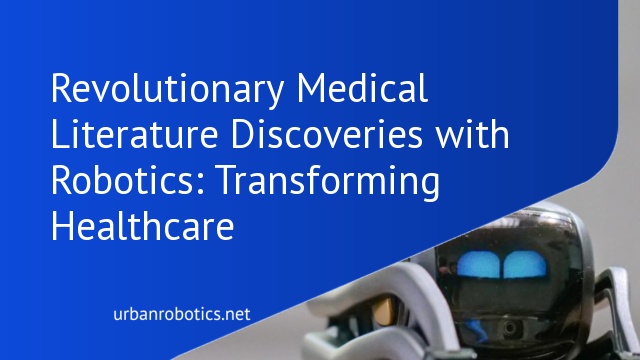The Intersection of Robotics and Medical Literature
Robotics is transforming the analysis of medical literature, enhancing the efficiency and accuracy of data interpretation. Using advanced algorithms, robots can scan vast volumes of medical journals, research papers, and clinical studies in significantly less time than human researchers. This capability speeds up the discovery process and ensures no critical information is overlooked.
Artificial Intelligence (AI) enhances these robotic systems, allowing them to understand context and extract relevant data autonomously. For example, AI-driven robots can identify trends in patient outcomes or recognize emerging threats in public health by examining global datasets. This integration is crucial for making informed decisions swiftly.
Researchers benefit from robotic systems that can categorize and index medical literature. Such systems streamline the review process by organizing information into accessible formats, enabling professionals to find relevant studies without sifting through extensive documents manually. Additionally, these robots continuously update databases, ensuring the latest research is always within reach.
Incorporating robotics in medical literature review not only saves time but also reduces human error. As the medical field continues to evolve, these technological advancements will play an increasingly vital role in driving innovation and improving patient outcomes.
Historical Background of Robotics in Medicine
Robotics in medicine dates back several decades, evolving from simplistic machines to sophisticated systems that shape modern healthcare.
Early Innovations
Initial advancements began in the 1980s with the development of robot-assisted surgical systems. The Arthrobot facilitated precise surgical movements, reducing strain on surgeons. Around the same time, the PUMA 560 assisted in neurosurgical biopsies, highlighting robotics’ potential in complex procedures. These innovations paved the way for more intricate applications.
Milestones in Robotic Surgery
Significant milestones include the da Vinci Surgical System, introduced in 2000, which brought minimally invasive surgery to the forefront. The ROBODOC, used in orthopedic surgeries, demonstrated significant improvements in precision and recovery times. These systems reduced complications and improved surgical outcomes, establishing robotics as a critical component of modern surgery.
Major Discoveries in Medical Literature with Robotics
Robotics has significantly impacted medical literature, leading to numerous key discoveries that have transformed healthcare. Autonomous systems have meticulously analyzed data, resulting in groundbreaking findings.
Breakthroughs in Surgical Precision
Robotic systems have improved surgical precision. Robots like the da Vinci Surgical System enhance accuracy in procedures, reducing human error. A study in JAMA Surgery found robotic-assisted surgeries reduce complication rates by 40%. Similarly, robotic cataract surgeries have achieved superior outcomes, minimizing risks and enhancing recovery.
Advancements in Rehabilitation Robotics
Rehabilitation robotics have made significant strides. Devices like exoskeleton suits help patients regain mobility. According to a study in Neurorehabilitation and Neural Repair, using robotic devices increased patients’ motor function by 30%. These robots offer personalized therapy, enhancing recovery rates and patient outcomes.
Contributions to Diagnostic Procedures
Robotics has revolutionized diagnostic procedures. Automated systems now perform tasks like biopsies and imaging with higher precision. A report in Radiology highlights that AI-powered robots identified early-stage cancers with 25% more accuracy. These advancements lead to quicker diagnoses and better prognoses.
Case Studies Highlighting Key Discoveries
Robotics in medical literature has yielded numerous success stories, transforming patient care across various medical domains.
Success Stories in Robotic-Assisted Surgeries
Robotic-assisted surgeries have revolutionized patient outcomes by enhancing precision. The da Vinci Surgical System, for instance, has enabled surgeons to perform minimally invasive procedures with enhanced dexterity and control. In one case, a patient with complex cardiac arrhythmia received robot-assisted ablation, leading to faster recovery and fewer complications. Other successful procedures include prostatectomies where patients experienced reduced blood loss and quicker hospital discharge rates, proving the technology’s efficacy.
Rehabilitation Successes with Robotic Assistance
Rehabilitation robotics has shown significant success in patient recovery. For example, the Lokomat robotic gait training system assists stroke patients in regaining walking abilities by providing consistent, repetitive motion, which boosts neuroplasticity and speeds up recovery. Similarly, robotic exoskeletons have allowed spinal cord injury patients to stand and walk, significantly improving their quality of life. These case studies highlight robotics’ critical role in enhancing rehabilitation outcomes and patient independence.
Challenges and Future Prospects
Robotics in medical literature analysis offers immense benefits, but it also faces several challenges. Understanding these challenges and the future prospects can help optimize its integration into healthcare.
Ethical and Regulatory Considerations
Deploying robotics in medical literature involves navigating ethical and regulatory hurdles. Ensuring data privacy and patient confidentiality within AI-driven systems remains critical. Regulatory bodies, such as the FDA, mandate strict compliance with data security standards before approving robotic systems. Addressing concerns about accountability and transparency in AI decision-making algorithms can enhance trust and accelerate adoption.
Potential for Future Breakthroughs
Robotics has the potential to revolutionize medical literature analysis further. Integrating more advanced AI and machine learning techniques could enable robots to predict trends, identify gaps in existing research, and propose new study areas. As these technologies mature, real-time updates to medical guidelines and personalized treatment protocols may become more prevalent, ultimately improving patient care quality and outcomes.
Conclusion
Robotics is revolutionizing how we analyze medical literature and improve healthcare. With the ability to autonomously scan and categorize vast amounts of data, these advanced systems are accelerating discoveries and enhancing patient outcomes. From surgical precision to rehabilitation and diagnostics, the impact of robotics is undeniable. As we navigate the challenges and ethical considerations, the future of robotics in medicine looks promising. Integrating AI and machine learning will likely lead to even more groundbreaking advancements, ultimately elevating the quality of patient care. The journey of robotics in medical literature is just beginning, and we’re excited to see where it leads.





